You have no items in your shopping cart.
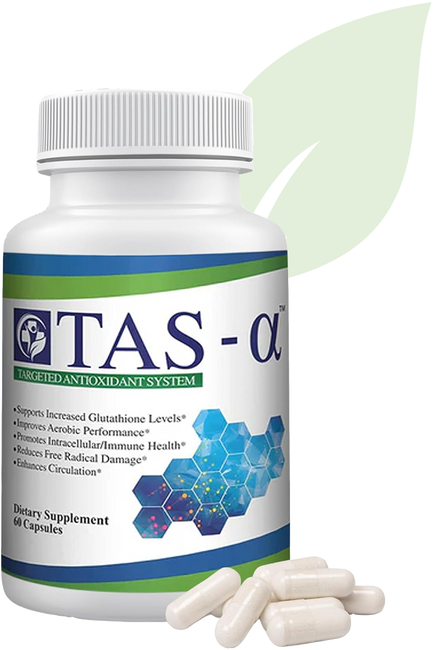
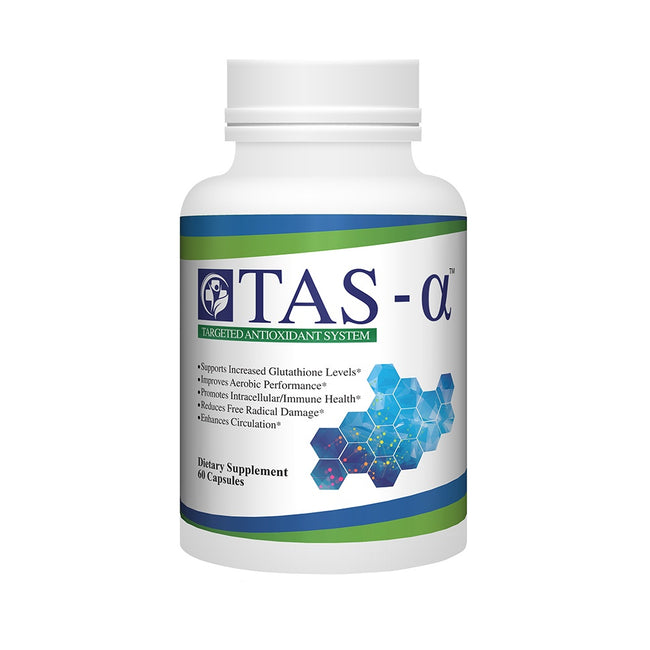
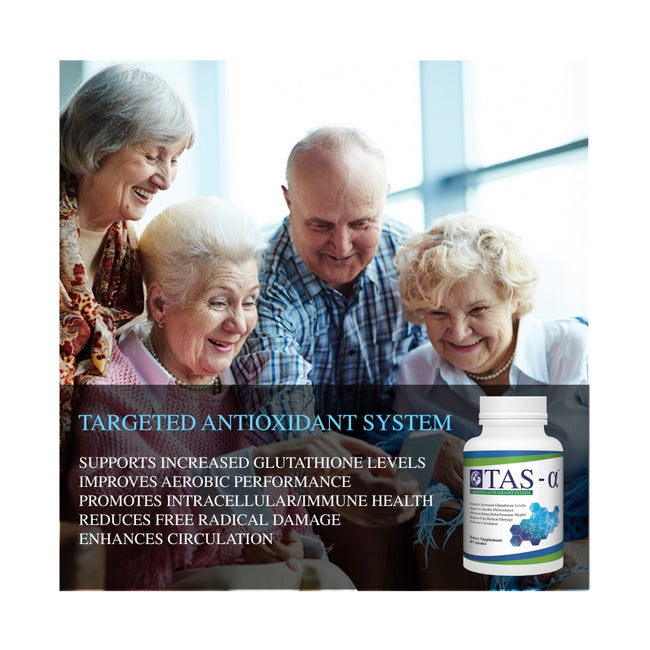
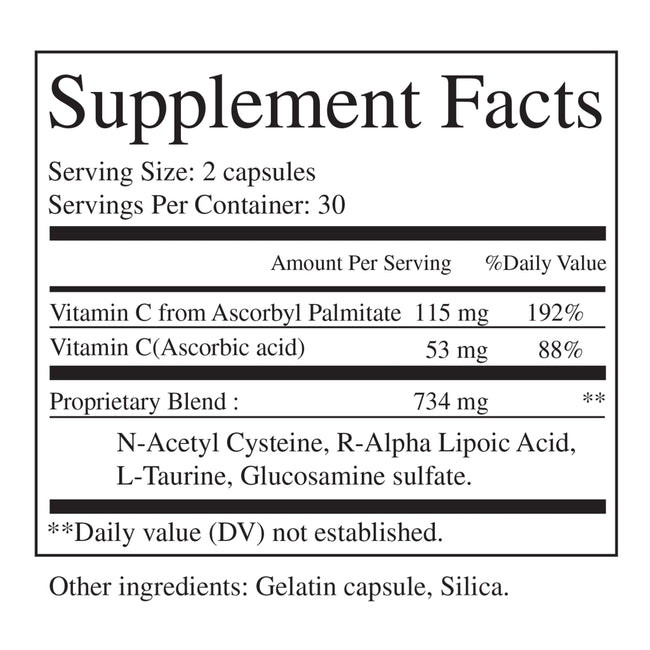
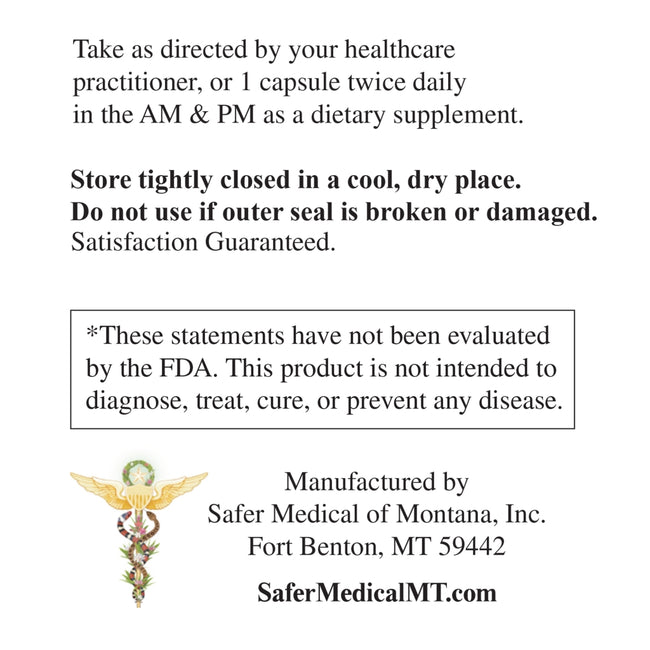
Targeted Antioxidant System
TAS-α is a 3rd-generation combination of efficient sources of intracellular cysteine—rate limiting components used for intracellular reassembly of the tripeptide glutathione (GSH) [1] TAS-α includes staged antioxidant resources that are designed to simultaneously maintain: GSH's antioxidant activity (refurbish GSSG to GSH); and GSH levels via reductions in the extracellular escape of GSSG.
Intracellular GSH promotes erythrocyte (—10/1 ) flexibility which is required both for their flow though typically smaller diameter capillaries (—5-8") and consequent oxygen and nutritional servicing of deeper and peripheral tissues.
TAS-α is a dietary supplement targeted at both maintaining intracellular glutathione (GSH) antioxidant levels and activity.
Intracellular GSH levels — poorly transported through cell walls are largem established Intracellulatly fromäts constituent amino acids glutamate, glycine, and cysteine — the latter being "rate-limiting" and consequently a target for efficient supplementation by TAS-α.
Subsequently, serving as an electron donor (as part of its intracellular roles) GSH is transformed into GSSG — which can readily pass though cell walls and may be lost into the extracellular media unless quickly refurbished by other antioxidant resources — the latter consequently also is a target of TAS-α.
GSH functions in several systems within the body that assist with: (1) Detoxification of fatsoluble compounds, (2) Supporting amino-acid transport, (3) DNA synthesis and immune system augmentation; as well as, (4) Quenching of free radical and other reactive oxygen species (ROS).
[e.g., This latter quenching activity — particularly with regard to promoting capillary microcirculation — is broadly important to: Performance (Physical and Mental),Stress(or)-Resistance, and Health/Wellbeing ][e.g., 2,3] Excessive ROS — and lower levels of GSH — have long-been associated with the pathogenesis of a variety of diseases that in part include: Cancer [7,13] Cardiovascular diseases (e.g., atherosclerosis; hypertension) Diabetes Mellitus [2,3, 7,131 Neurological disorders (e.g., Alzheimer's & Parkinson's diseases) Pulmonary diseases (e.g., Asthma, Acute-Respiratory-Distress-Syndrome/ARDS), Chronic-Obstructive-Pulmonary-Disease/COPD) ][ 1 '2'6'8'9' 13] Rheumatoid Arthritis. • [e.g., 10,13] Viral Bacterial Infection/Reduced Immunity [e.g., Aging is strongly associated with several of the above diseases; hence, it is not surprising that both: (l) Excessive ROS, and lower levels of GSH, have been associated with accelerated aging; and (2) Targeted antioxidants — eg.
TAS-a — identified as a means for intervention to enhance mental and physical performance, stress resistance as well as health/wellbeing.][e.g., 2-7,11]
Ingredients:
Vitamin C(from Ascorbyl Palmitate) Vitamin C(Ascorbic Acid) Proprietary Blend: N-Acetyl Cysteine, R-Alpha Lipoic Acid, Glucosamine Sulfate, Other Ingredients: Gelatin Capsule, Silica
Take 1 capsule twice daily AM & PM as a Dietary Supplement, or Directed by your health care professional
References
Anderson ME (1997). Glutathione and glutathione delivery compounds. Adv Pharmacol;38, 65-78.
Bittner, A.C. & Sakuragi, Y. (2006). Intra-Individual Ergonomics (12E): Framework and future. Proc 50th Meet Hum Fac and Ergo soc (pp. 2533-2537). Santa Monica, CA: HFES.
Bittner, A.C., Lile, K., Bittner, RCL & Sakuragi, Y. (2007). Intra-Individual Ergonomics (12E): Performance effects of ultra-negative-ion water. Proc 51st Ann Meet Hum Fact and Ergo Soc (pp. 1617-1621).
Santa Monica, CA: HFES.
Cai J, Chen Y, Seth S, Furukawa S, Compans RW & Jones DP (2003). Inhibition of influenza infection by glutathione. Free Radical Bio & Med; 34(7), 928-936.
Calabrese V, Guagliano E, Sapienza M, Panebianco M, Calafato S, Puleo E, Pennisi G, Mancuso C, Butterfield DA, Stella AG. (2007). Redox regulation of cellular stress response in aging and neurodegenerative disorders: role ofvitagenes. 757-773.
Fattman CL, Schaefer LM & Oury TD (2003). Extracellular superoxide dismutase in biology and medicine. Free Radical Bio & Med; 35(3), 236-256.
Flora SJ (2007). Role of free radicals and antioxidants in health and disease. Cell Mol Biol; 53(1):1-2 [Introductory Overview].
Gul M, Kutay FZ, Temocin S, et al. (2000). Cellular and clinical implications of glutathione. Indian J Exp Biol; 38:625-634.
Lomaestro B, Malone M. (1995). Glutathione in health and disease: pharmacotherapeutic issues. Ann Pharmacother; 29: 1263—1273.
Macchia I, Palamara AT, Bué C, Savini P, Ciriolo Met al., (1999). Increased replication of sendai virus in morphine-treated epithelial cells: evidence for the involvement of the intracellular levels of glutathione. Internat. J. ofImmunopharm; 21(3):185-193.
Mancuso C Scapagini G, Currö D, Giuffrida Stella AM, De Marco C, Butterfield DA, Calabrese V. (2007). Mitochondrial dysfunction, free radical generation and cellular stress response in neurodegenerative disorders. Front Biosci.
Strålin P, Jacobsson H. & Marklund SL (2002). Oxidative stress, NO and smooth muscle cell extracellular superoxide dismutase expression. Biochimica et Biophysica; 1619(1, 2):1-8
Valko M, Leibfritz D, Moncol J, Cronin MT, Mazur M & Telser J. (2007). Free radicals and antioxidants in normal physiological functions and human disease. Int J Biochem Cell Biol. ;39(1):44-84.[/vc_column_text][/vc_column][/vc_row]
Targeted Antioxidant System
TAS-α is a 3rd-generation combination of efficient sources of intracellular cysteine—rate limiting components used for intracellular reassembly of the tripeptide glutathione (GSH) [1] TAS-α includes staged antioxidant resources that are designed to simultaneously maintain: GSH's antioxidant activity (refurbish GSSG to GSH); and GSH levels via reductions in the extracellular escape of GSSG.
Intracellular GSH promotes erythrocyte (—10/1 ) flexibility which is required both for their flow though typically smaller diameter capillaries (—5-8") and consequent oxygen and nutritional servicing of deeper and peripheral tissues.
TAS-α is a dietary supplement targeted at both maintaining intracellular glutathione (GSH) antioxidant levels and activity.
Intracellular GSH levels — poorly transported through cell walls are largem established Intracellulatly fromäts constituent amino acids glutamate, glycine, and cysteine — the latter being "rate-limiting" and consequently a target for efficient supplementation by TAS-α.
Subsequently, serving as an electron donor (as part of its intracellular roles) GSH is transformed into GSSG — which can readily pass though cell walls and may be lost into the extracellular media unless quickly refurbished by other antioxidant resources — the latter consequently also is a target of TAS-α.
GSH functions in several systems within the body that assist with: (1) Detoxification of fatsoluble compounds, (2) Supporting amino-acid transport, (3) DNA synthesis and immune system augmentation; as well as, (4) Quenching of free radical and other reactive oxygen species (ROS).
[e.g., This latter quenching activity — particularly with regard to promoting capillary microcirculation — is broadly important to: Performance (Physical and Mental),Stress(or)-Resistance, and Health/Wellbeing ][e.g., 2,3] Excessive ROS — and lower levels of GSH — have long-been associated with the pathogenesis of a variety of diseases that in part include: Cancer [7,13] Cardiovascular diseases (e.g., atherosclerosis; hypertension) Diabetes Mellitus [2,3, 7,131 Neurological disorders (e.g., Alzheimer's & Parkinson's diseases) Pulmonary diseases (e.g., Asthma, Acute-Respiratory-Distress-Syndrome/ARDS), Chronic-Obstructive-Pulmonary-Disease/COPD) ][ 1 '2'6'8'9' 13] Rheumatoid Arthritis. • [e.g., 10,13] Viral Bacterial Infection/Reduced Immunity [e.g., Aging is strongly associated with several of the above diseases; hence, it is not surprising that both: (l) Excessive ROS, and lower levels of GSH, have been associated with accelerated aging; and (2) Targeted antioxidants — eg.
TAS-a — identified as a means for intervention to enhance mental and physical performance, stress resistance as well as health/wellbeing.][e.g., 2-7,11]
Ingredients:
Vitamin C(from Ascorbyl Palmitate) Vitamin C(Ascorbic Acid) Proprietary Blend: N-Acetyl Cysteine, R-Alpha Lipoic Acid, Glucosamine Sulfate, Other Ingredients: Gelatin Capsule, Silica
Take 1 capsule twice daily AM & PM as a Dietary Supplement, or Directed by your health care professional
References
Anderson ME (1997). Glutathione and glutathione delivery compounds. Adv Pharmacol;38, 65-78.
Bittner, A.C. & Sakuragi, Y. (2006). Intra-Individual Ergonomics (12E): Framework and future. Proc 50th Meet Hum Fac and Ergo soc (pp. 2533-2537). Santa Monica, CA: HFES.
Bittner, A.C., Lile, K., Bittner, RCL & Sakuragi, Y. (2007). Intra-Individual Ergonomics (12E): Performance effects of ultra-negative-ion water. Proc 51st Ann Meet Hum Fact and Ergo Soc (pp. 1617-1621).
Santa Monica, CA: HFES.
Cai J, Chen Y, Seth S, Furukawa S, Compans RW & Jones DP (2003). Inhibition of influenza infection by glutathione. Free Radical Bio & Med; 34(7), 928-936.
Calabrese V, Guagliano E, Sapienza M, Panebianco M, Calafato S, Puleo E, Pennisi G, Mancuso C, Butterfield DA, Stella AG. (2007). Redox regulation of cellular stress response in aging and neurodegenerative disorders: role ofvitagenes. 757-773.
Fattman CL, Schaefer LM & Oury TD (2003). Extracellular superoxide dismutase in biology and medicine. Free Radical Bio & Med; 35(3), 236-256.
Flora SJ (2007). Role of free radicals and antioxidants in health and disease. Cell Mol Biol; 53(1):1-2 [Introductory Overview].
Gul M, Kutay FZ, Temocin S, et al. (2000). Cellular and clinical implications of glutathione. Indian J Exp Biol; 38:625-634.
Lomaestro B, Malone M. (1995). Glutathione in health and disease: pharmacotherapeutic issues. Ann Pharmacother; 29: 1263—1273.
Macchia I, Palamara AT, Bué C, Savini P, Ciriolo Met al., (1999). Increased replication of sendai virus in morphine-treated epithelial cells: evidence for the involvement of the intracellular levels of glutathione. Internat. J. ofImmunopharm; 21(3):185-193.
Mancuso C Scapagini G, Currö D, Giuffrida Stella AM, De Marco C, Butterfield DA, Calabrese V. (2007). Mitochondrial dysfunction, free radical generation and cellular stress response in neurodegenerative disorders. Front Biosci.
Strålin P, Jacobsson H. & Marklund SL (2002). Oxidative stress, NO and smooth muscle cell extracellular superoxide dismutase expression. Biochimica et Biophysica; 1619(1, 2):1-8
Valko M, Leibfritz D, Moncol J, Cronin MT, Mazur M & Telser J. (2007). Free radicals and antioxidants in normal physiological functions and human disease. Int J Biochem Cell Biol. ;39(1):44-84.[/vc_column_text][/vc_column][/vc_row]











